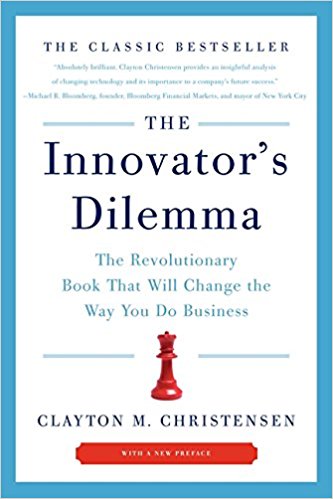Innovation is crucial to business performance and success and Digital Transformation is the precursor to creating the environment within which innovators can thrive. The key point here is that transforming organizations into digital ones is a major challenge, and probably the biggest business challenge for the majority of them, however Digital Transformation is just the starting point and not an end goal.
Digital Transformation is a prerequisite for future business success because it opens the door to innovation and the ability to break the mold into which so many brands become cemented into. A good case in point is Sears, once America’s largest retailer, but which is now on the verge of bankruptcy in the face of growing competition from digitally-based disruptors, such as Amazon.
Sears is not alone: Macy’s is considered by analysts to have more value due to its real estate portfolio than is derived from retail operations, while US retail store closures are expected to surpass 8,000 in 2017 (a sad record). It is not just the retail sector that is affected either, telecommunications, banking, insurance, distribution and logistics, professional services (law, accounting, medical), and others are all suffering the pain.
Given the digital environment we are now living and operating within, companies are subject to the real-time demands of consumers like never before. Almost every service offered is either commoditized or approaching this state, which means businesses either learn to deliver goods and services how their customers want them, or they will lose customers to a ‘disruptor’ who will.
Breaking the Chains of Innovation
The concept of the “Innovator’s Dilemma” originates from Harvard Business School professor Clayton Christensen, and broadly outlines the rut that brands and organizations can fall into as they reach the peak of success from innovating.
Eventually, the organizational attitude moves from “How do we make this better?” to “This isn’t broke, so let’s not fix it.” The innovative spirit is supplanted by an organizational culture which seeks to maintain the status quo.
Maintaining the status quo means balance and innovation cannot thrive here.
Conversely, innovation implies deliberately introducing disruption and change. Change can be a frightening thing, however, this is where many organizations are right now.
The question is how do we introduce a healthy degree of organizational innovation without losing control over the process of innovation, and also preventing a lapse into stagnation?
The Lean BPM Approach to Innovation with Control
Lean BPM provides a work and process management platform which can be used directly by the people working at the coal face of a business.
The exciting part of Digital Transformation is typically seen to be at the customer-facing end of the operation, where multiple touch points can be provided for people to interact with the organization (and buy from it), plus there is all that lovely Big Data you can collect.
The frustration here is that technology is unable to keep pace with customer-driven demands, which change extremely quickly and invite businesses to develop new and innovative ways of engaging and interacting with them.
The major bottleneck at this point is the inability of IT teams and IT infrastructure to keep up with demands of customers communicated to them by the business. Implementing change and providing technical expression has traditionally been a time-consuming, complicated and very costly exercise (and we should also give a hat tip to the fear created by introducing improvement consultants and Lean/Six Sigma teams on the existing staff).
Lean BPM bypasses the delay and cost associated with the coding and development effort traditionally required, because it simply does not require this. Instead, processes and workflows can be replicated or designed within Visual Workflow tools, using simple drag-and-drop functionality combined with Excel-like formulas for business logic and rules creation.
This simplicity means that non-specialists can use a Lean BPM platform, with minimal training and no specialist development skills. However, this simplicity does not imply a lack of power and functionality, far from it, as complex processes can be created, managed and optimized within the platform, which itself can be scaled globally. This simplicity and ease of use also greatly speeds up the process of creating and managing business processes, which also further reduces cost.
Increasingly, Enterprise Architects are awakening to the potential of low code, no code, and Lean BPM tools for providing the ordinary business person (The Citizen Developer) with a protected environment, within which they can create, manage, and improve processes and workflows with minimal hand-holding from IT, coders and developers.
Achieving Innovation Agility and Maintaining Management Control
“Agility” has become an overplayed term, especially from technology marketing teams who like to refer to everything about their product as “agile.” CIOs and senior managers understand only too well the conundrum of introducing business agile solutions that also introduce a lack of business stability, while becoming a management headache, because traditional reporting is simply not fast or effective enough at providing timely information and data.
Introducing disruption as a way of doing business simply complicates the issue.
However, Lean BPM provides a universal work platform which collects, manages and archives information in a digital format. This means that reporting can also be automated, as can escalation, alerts, notifications and the ‘baking-in’ of compliance rules and business policies. Lean BPM platforms open the door to Digital Transformation precisely because they handle everything in a digital fashion, even when the tool interacts with real-world assets and people.
In addition to automating reporting and so on, Lean BPM platforms also store every action on the platform, down to mouse click and keyboard entry, and this is all associated with the operator (no matter who they are). In HighGear, we refer to this functionality as the Audit Trail, and it records every action on the platform, including maintaining a complete record of who logs in and when, what actions they perform at both user and system-wide levels, and irrespective of their status (so system administrators also have everything they do recorded too).
This combination of real-time alerts, automatic escalation and reporting, combined with the Audit Trail means granular accountability and visibility are introduced across all processes and work carried out on the HighGear platform.
Finally, speed and agility can be employed to innovate and disrupt, but without the loss of control traditional solutions have brought with them.
Bringing Work and Change Under Control at Speed
A further issue with Digital Transformation is how do you bring chaos under control. Most organizations are operating without standardization across departments and teams, with a hotchpotch of tools being employed in a haphazard manner, such as email, Post-It notes, memos, telephone, Instant Messaging, and so on.
There is frequently disagreement on just how a process operates, even for small teams managing a small part of a process.
Process visibility is generally poor, managing work involves substantial guess work, and gauging results and performance involves too much estimation for process optimization purposes.
The analogy here is that work organization frequently represents a burning oil platform, with fires continually breaking out and which must be put out, only for more to reappear elsewhere. This creates confusion and inefficiency, a great deal of frustration, and overall a poor level of performance.
Traditional work management solutions, especially those associated with Big BPM providers, require you model the environment. You must work out the As Is state in order to then figure out what the “To Be” state should be, and formulate and execute your plan on how to get there. All the while, you must enforce control to prevent a relapse back to the “As Is” state.
Good luck!
Lean BPM’s approach relies upon its speed, agility, and user ease of use.
Users are able to ‘map’ the existing workflows and processes directly into the Visual Workflow. If all of the process is not yet visible, or agreed upon, then part of the process can be replicated initially, and then added in incremental blocks such that the real As Is state emerges (we have discussed Emergence Theory in this regard previously).
What this means is that you create visibility on how work is done now!
Once you have visibility on work, you can simply establish measurement and now you are collecting real-world data (rather than estimated data used for modelling purposes).
You now have the basis for introducing process improvement using real data, gathered from how work is actually getting done in the specific process under consideration.
Digital Transformation opens the door to continuous and innovative business improvement, which is arguably the end goal rather than transformation per se. Lean BPM and other technologies may give you the ability to transform, but ultimately it will be how your organization and people use the powerful new functionality now available which will determine your business success or failure.
Ultimately, organizational culture is going to play a much greater role in business performance given the technology bottleneck to Digital Transformation is now removed.
Summary
Digital Transformation is the starting point for moving to a digital organization and not the end goal.
Avoiding the Innovation Dilemma means introducing and managing a healthy innovative attitude which is not stifled by the drive to establish and maintain the status quo.
Lean BPM delivers an environment for Citizen Developers to innovate, but without the loss of control and visibility which concerns management.
Lean BPM provides a digital work platform which provides for automation of reporting, escalation, alerts and notifications, combined with an Audit Trail that introduces personal and team accountability and granular visibility.
Lean BPM pioneer, HighGear, provides a universal work platform which provides the foundation for Digital Transformation, delivering business agility, speed in use and deployment, yet harnessed by reporting and compliance functionality that allows disruption and innovation to be managed effectively.


